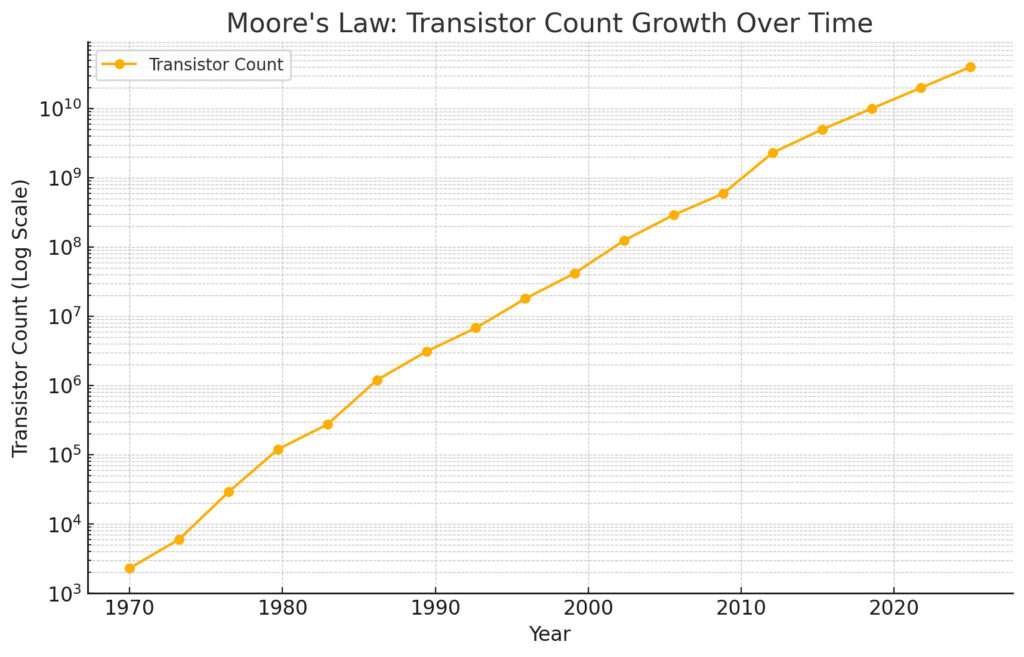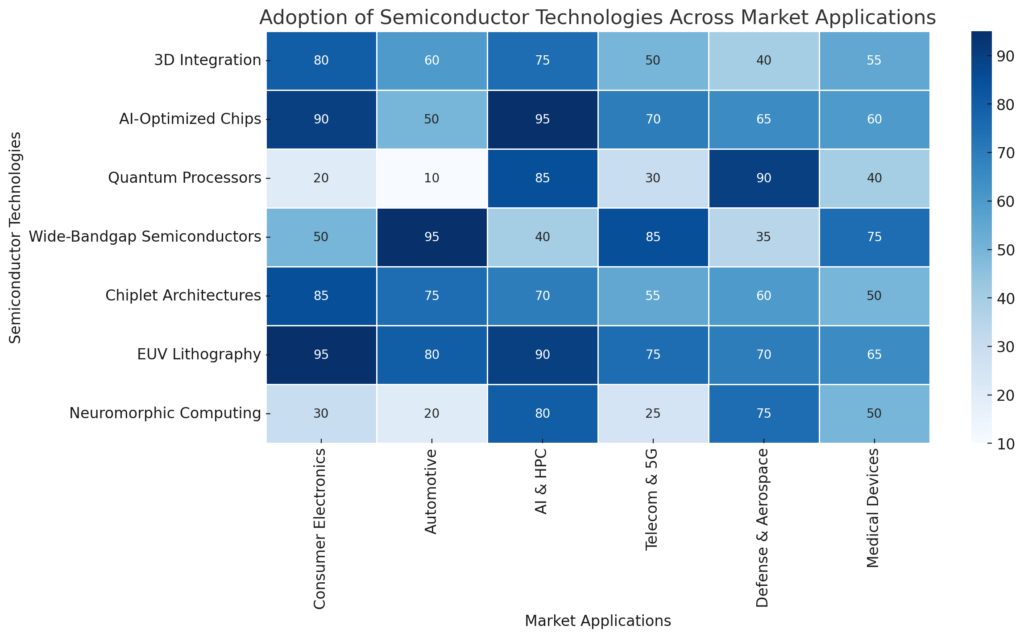
The Future of Semiconductor Technology: Innovations, Trends, and Industry Outlook
By Bert Templeton
Abstract
The field of semiconductor technology is undergoing an unprecedented transformation, propelled by groundbreaking advancements in materials science, microfabrication methodologies, and computational architectures. This paper comprehensively analyzes the trajectory of semiconductor research and development, scrutinizing key areas such as transistor scaling paradigms, advanced chip packaging methodologies, emergent material innovations, artificial intelligence-enhanced semiconductor design, and the geopolitical dynamics influencing global supply chains. The discourse incorporates insights from prominent industry stakeholders, including Intel, TSMC, AMD, Samsung, Texas Instruments, Renesas, Apple, Micron, NXP, NVIDIA, and Qualcomm, alongside pivotal research from leading academic institutions worldwide. Data-driven projections are presented to forecast the evolution of semiconductor technology over the next decade, supported by empirical research and industry case studies.
Introduction
Semiconductors are the cornerstone of modern computational systems, facilitating technological advancements across a broad spectrum of applications ranging from consumer electronics to high-performance computing and artificial intelligence. As the demand for computational efficiency, miniaturization, and energy optimization intensifies, the semiconductor industry confronts profound challenges in scaling and innovation. This paper delves into cutting-edge research, exploring the frontiers of semiconductor technology and its implications for future developments.
1. Moore’s Law and the Paradigm Shift in Scaling

1.1 The Implications of Scaling Limits
Moore’s Law, which historically predicted exponential growth in transistor density, is facing fundamental physical constraints that necessitate alternative approaches to performance enhancement. Contemporary semiconductor fabrication has reached sub-5nm nodes, with TSMC pioneering 2nm technology and Intel advancing its 18A (1.8nm) node. However, the efficacy of continued miniaturization is increasingly challenged by quantum mechanical effects and interconnect bottlenecks.
1.2 3D Integration and Advanced Heterogeneous Packaging
The emergence of three-dimensional (3D) integration technologies, exemplified by Intel’s Foveros, TSMC’s 3DFabric, and AMD’s 3D V-Cache, has redefined the scaling paradigm. These methodologies facilitate vertical chip stacking, thereby mitigating latency, power dissipation, and signal integrity issues inherent in conventional planar scaling. Advanced packaging solutions, including chiplet architectures, are poised to supplant traditional monolithic designs, offering modular scalability and enhanced computational efficiency.
2. Next-Generation Semiconductor Materials
2.1 Wide-Bandgap and Ultrawide-Bandgap Semiconductors
Beyond silicon, gallium nitride (GaN) and silicon carbide (SiC) revolutionize power electronics by delivering superior thermal conductivity, breakdown voltage, and energy efficiency. These advancements are particularly significant in electric vehicles (EVs), 5G infrastructure, and high-frequency power applications. Research at institutions such as MIT and Stanford is actively investigating novel fabrication techniques to integrate these materials into next-generation semiconductor devices.
2.2 2D Materials and Carbon Nanotube Transistors
Two-dimensional (2D) materials, including graphene and transition metal dichalcogenides (TMDs), exhibit extraordinary electronic properties, such as high carrier mobility and superior mechanical strength. IBM and Samsung have pioneered carbon nanotube-based transistor architectures, positioning them as potential successors to silicon-based technology in future semiconductor nodes.

3. Artificial Intelligence in Semiconductor Design
3.1 AI-Optimized Chip Architectures
Machine learning algorithms are redefining semiconductor design methodologies, with Google’s Tensor Processing Unit (TPU) serving as a prime example of AI-driven chip layout optimization. NVIDIA and Qualcomm are integrating AI techniques to accelerate the design, verification, and fabrication processes, thereby reducing time-to-market and enhancing chip performance.
3.2 Neuromorphic and Brain-Inspired Computing
Neuromorphic computing architectures, such as Intel’s Loihi and IBM’s TrueNorth, emulate the synaptic plasticity of biological neural networks, offering highly efficient and parallelized processing capabilities. Academic research from institutions such as Stanford and MIT drives innovations in this domain, with potential applications in energy-efficient AI acceleration and real-time inference processing.
4. Quantum Computing and Semiconductor Evolution
4.1 Superconducting and Silicon-Based Quantum Processors
Quantum computing is poised to revolutionize computational paradigms, with IBM, Google, and Intel actively developing superconducting qubit architectures. Parallel research at Delft University and the University of New South Wales (UNSW) is exploring silicon-based quantum computing, which offers seamless integration with existing semiconductor fabrication methodologies.
4.2 Alternative Qubit Implementations
Efforts at Oxford and Harvard are focused on room-temperature quantum computing solutions, leveraging diamond-based nitrogen-vacancy (NV) centers and topological qubits to enhance coherence times and computational stability.
5. Semiconductor Manufacturing Innovations

5.1 Advancements in Lithography and Extreme Ultraviolet (EUV) Technology
The advent of extreme ultraviolet (EUV) lithography, pioneered by ASML, has enabled the transition to sub-5nm fabrication nodes. The next frontier in lithographic innovation is high-numerical aperture (High-NA) EUV, which is expected to enhance feature resolution and process scalability further. Leading semiconductor manufacturers, including TSMC, Samsung, and Intel, heavily invest in these advancements to sustain their competitive edge.
5.2 Chiplet Integration and Heterogeneous Computing Paradigms
The proliferation of chiplet-based architectures, as exemplified by AMD’s Ryzen processors, underscores a shift toward modular and scalable semiconductor design. National initiatives, such as the U.S. CHIPS Act and the European semiconductor strategy, are fostering domestic investments in heterogeneous integration and advanced packaging techniques to bolster technological sovereignty.
6. Market Dynamics and Geopolitical Considerations
6.1 Supply Chain Resilience and Strategic Investments
Geopolitical tensions have underscored the criticality of semiconductor supply chain diversification. The U.S. and EU are pursuing strategic initiatives to mitigate dependency on Asian fabrication hubs, with Taiwan’s geopolitical volatility influencing global semiconductor logistics and manufacturing strategies.
6.2 Sustainability and the Drive Toward Carbon-Neutral Semiconductor Manufacturing
Environmental sustainability is becoming an industry priority, with companies like Intel and Samsung committing to carbon-neutral fabrication processes. Emerging innovations in semiconductor recycling and energy-efficient materials are being explored to minimize environmental impact and enhance resource sustainability.
Conclusion
Multifaceted advancements spanning transistor scaling, alternative materials, AI-enhanced design, and novel computing paradigms are shaping the trajectory of semiconductor technology. The synergy between industry-driven innovation and academic research fosters groundbreaking developments in quantum and neuromorphic computing. As the semiconductor sector navigates geopolitical uncertainties and sustainability imperatives, continued investments in manufacturing resilience and technological diversification will be paramount for sustaining future progress.